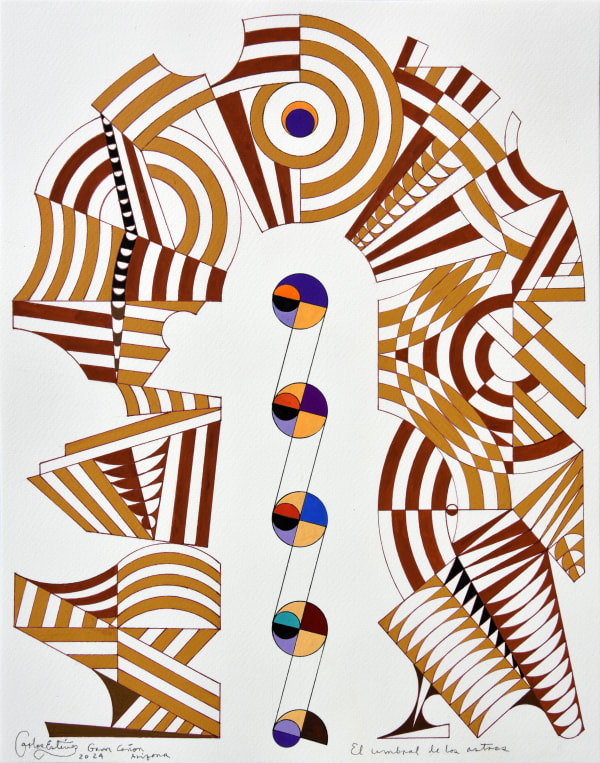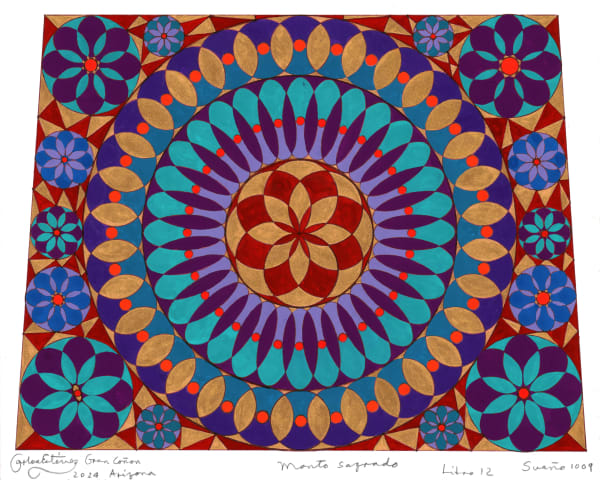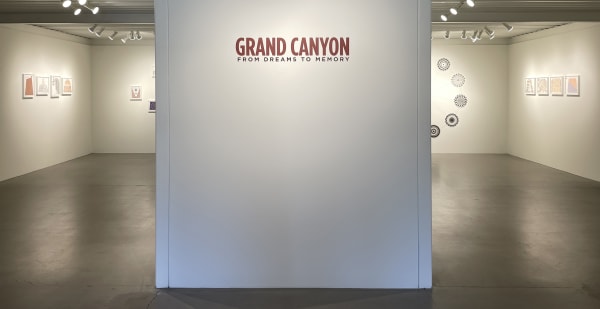Grand Canyon: From Dreams to Memory
This fall’s group show at Lisa Sette Gallery, Grand Canyon: From Dreams to Memory, considers Arizona’s site of deep time and vast transformation as experienced by dreamers, immigrants, and spirits passing through. With the fresh perspective of witnessing this wonder of the world for the first time, artworks included in the exhibit explore the profusion of meanings and implications that echo from the Grand Canyon’s fathomless depths. A public opening for the exhibition will take place on Saturday, October 19th, 2024 from 1:00-3:00pm with several artists in attendance.
Beyond the abstract boundaries of citizenship or residency, artists featured in Grand Canyon: From Dreams to Memory depict their experiences of this vast geological chasm through global backgrounds and diverse landscapes, from the new aesthetics of contemporary identity to timeless spiritual and planetary connections. Seven artists from six countries comprise the exhibition: Enrique Chagoya (Mexico), Tseng Kwong Chi (Hong Kong), Binh Danh (Vietnam), Carlos Estévez (Cuba), Siri Devi Khandavilli (India), Arno Rafael Minkkinen (Finland), and Reynier Leyva Novo (Cuba).
-
 Arno Rafael Minkkinen, Grand Canyon, Arizona , 1995
Arno Rafael Minkkinen, Grand Canyon, Arizona , 1995 -
 Enrique Chagoya, Encounter at the Border of Language, 2024
Enrique Chagoya, Encounter at the Border of Language, 2024 -
 Tseng Kwong Chi, Grand Canyon, Arizona (E68m4.20), 1987; printed 2005
Tseng Kwong Chi, Grand Canyon, Arizona (E68m4.20), 1987; printed 2005 -
 Tseng Kwong Chi, Grand Canyon, Arizona (E70m4.20), 1989
Tseng Kwong Chi, Grand Canyon, Arizona (E70m4.20), 1989
-
 Binh Danh, Grand Canyon (#1), 2024
Binh Danh, Grand Canyon (#1), 2024 -
 Binh Danh, Grand Canyon #5, 2016
Binh Danh, Grand Canyon #5, 2016 -
 Reynier Leyva Novo, You and the Whole are the Same (from the Honey Pools series), 2024
Reynier Leyva Novo, You and the Whole are the Same (from the Honey Pools series), 2024 -
 Reynier Leyva Novo, The Grand Canyon is the Distance Between This Place and Some Stone (From the Honey Pools series), 2024
Reynier Leyva Novo, The Grand Canyon is the Distance Between This Place and Some Stone (From the Honey Pools series), 2024
-
 Carlos Estévez, Sacred Source, 2024
Carlos Estévez, Sacred Source, 2024 -
 Carlos Estevez, Templo de las miradas, 2024
Carlos Estevez, Templo de las miradas, 2024 -
 Carlos Estévez, Flor onírica. Sueño 1051. Libro 13, 2024
Carlos Estévez, Flor onírica. Sueño 1051. Libro 13, 2024 -
 Carlos Estevez, Solstitium. Sueño 1047. Libro 13, 2024
Carlos Estevez, Solstitium. Sueño 1047. Libro 13, 2024
-
 Carlos Estevez, Pájaro perpetuo, 2024
Carlos Estevez, Pájaro perpetuo, 2024 -
 Carlos Estevez, Scenarium, 2024
Carlos Estevez, Scenarium, 2024 -
 Carlos Estévez, Templo iniciático, 2024
Carlos Estévez, Templo iniciático, 2024 -
 Carlos Estevez, Templo cósmico, 2024
Carlos Estevez, Templo cósmico, 2024
-
 Carlos Estévez, Templo mutante, 2024
Carlos Estévez, Templo mutante, 2024 -
 Carlos Estevez, El umbral de los astros, 2024
Carlos Estevez, El umbral de los astros, 2024 -
 Carlos Estevez, Volando sobre el Gran Cañon. Sueño 1021. Libro 12, 2024
Carlos Estevez, Volando sobre el Gran Cañon. Sueño 1021. Libro 12, 2024 -
 Carlos Estevez, Zigurat, 2024
Carlos Estevez, Zigurat, 2024
-
 Carlos Estévez, Anfiteatro, 2024
Carlos Estévez, Anfiteatro, 2024 -
 Carlos Estévez, Joya onírica. Sueño 1007. Libro 12, 2024
Carlos Estévez, Joya onírica. Sueño 1007. Libro 12, 2024 -
 Carlos Estevez, Palacio telúrico, 2024
Carlos Estevez, Palacio telúrico, 2024 -
 Carlos Estévez, Eclipse onírico de luna. Sueño 1024. Libro 12, 2024
Carlos Estévez, Eclipse onírico de luna. Sueño 1024. Libro 12, 2024
-
 Carlos Estevez, Piedra talisman. Sueño 1041. Libro 13, 2024
Carlos Estevez, Piedra talisman. Sueño 1041. Libro 13, 2024 -
 Carlos Estévez, Fósil oráculo. Sueño 1023. Libro 12, 2024
Carlos Estévez, Fósil oráculo. Sueño 1023. Libro 12, 2024 -
 Carlos Estévez, Eclipse amuleto, 2024
Carlos Estévez, Eclipse amuleto, 2024 -
 Carlos Estevez, Circo gravitatorio, 2024
Carlos Estevez, Circo gravitatorio, 2024
-
 Carlos Estevez, Desierto de columnas. Sueño 1006. Libro 12, 2024
Carlos Estevez, Desierto de columnas. Sueño 1006. Libro 12, 2024 -
 Carlos Estevez, Manto sagrado. Sueño 1009. Libro 12, 2024
Carlos Estevez, Manto sagrado. Sueño 1009. Libro 12, 2024 -
 Carlos Estévez, Pájaro fósil. Sueño 1022, 2024
Carlos Estévez, Pájaro fósil. Sueño 1022, 2024 -
 Carlos Estevez, Retrato de mujer hindú. Sueño 1017. Libro 12, 2024
Carlos Estevez, Retrato de mujer hindú. Sueño 1017. Libro 12, 2024
-
 Carlos Estevez, Reloj de luz, 2024
Carlos Estevez, Reloj de luz, 2024 -
 Carlos Estévez, Eclipse ceremonial, 2024
Carlos Estévez, Eclipse ceremonial, 2024 -
 Carlos Estévez, Eclipse cardumen, 2024
Carlos Estévez, Eclipse cardumen, 2024 -
 Carlos Estévez, Eclipse de estrellas, 2024
Carlos Estévez, Eclipse de estrellas, 2024
-
 Carlos Estévez, Eclipse de lluvia, 2024
Carlos Estévez, Eclipse de lluvia, 2024 -
 Carlos Estévez, Eclipse de mar, 2024
Carlos Estévez, Eclipse de mar, 2024 -
 Carlos Estévez, Eclipse de pájaros, 2024
Carlos Estévez, Eclipse de pájaros, 2024 -
 Carlos Estevez, Eclipse de serpiente, 2024
Carlos Estevez, Eclipse de serpiente, 2024
Grand Canyon: From Dreams to Memory
Exhibition
October 5, 2024 - December 28, 2024
Opening Reception with Artists
Saturday, October 19, 2024
1:00 - 3:00pm
This fall’s group show at Lisa Sette Gallery, Grand Canyon: From Dreams to Memory, considers Arizona’s site of deep time and vast transformation as experienced by dreamers, immigrants, and spirits passing through. With the fresh perspective of witnessing this wonder of the world for the first time, artworks included in the exhibit explore the profusion of meanings and implications that echo from the Grand Canyon’s fathomless depths. A public opening for the exhibition will take place on Saturday, October 19th, 2024 from 1:00-3:00pm with several artists in attendance.
Beyond the abstract boundaries of citizenship or residency, artists featured in Grand Canyon: From Dreams to Memory depict their experiences of this vast geological chasm through global backgrounds and diverse landscapes, from the new aesthetics of contemporary identity to timeless spiritual and planetary connections. Seven artists from six countries comprise the exhibition: Enrique Chagoya (Mexico), Tseng Kwong Chi (Hong Kong), Binh Danh (Vietnam), Carlos Estévez (Cuba), Siri Devi Khandavilli (India), Arno Rafael Minkkinen (Finland), and
Reynier Leyva Novo (Cuba).
Cuban artist Carlos Estévez was awarded an artists’ residency at the Grand Canyon Conservancy beginning on April 8, 2024, the date of a spectacular total solar eclipse. Estévez remarks: I perceived this astronomical phenomenon as a sign marking the beginning of my stay, and began a series titled "Intimate Eclipses," depicting imaginary eclipses in black and white. These were an introduction to the majesty and imposing presence of the new landscape surrounding me.
Focused on “a dialogue with nature and with myself,” Estévez’s enchanting ink and tempera drawings in the round depict mysteriously connected cosmic structures. Both in these mandala-like orbiting constructions and in his rectangular drawings, Estévez’s works chart the journey of human perception through the vast fields of time and space. The Grand Canyon appears as a temple to our spiritual passage in this world, and the artist a witness to the grand unfolding of the universe. The artist remarks: These works serve as testimony and documentation of my conversation with nature. Eclipses, temples, and dreams are the fundamental themes embodying my vision of the Grand Canyon.
Sculptor Siri Devi Khandavilli first saw the Grand Canyon when she was “about 15 days old in America,” after moving from Bangalore to Arizona to get married. She remarks: There is no not falling in love with the Grand Canyon. It is almost not earth-like when you see it for the first time.
Drawing on the Canyon’s vast geological document of change, and the transformational moment of experiencing it as a newcomer, Khandavilli portrays the Canyon as a source of spiritual reference and personal remaking; she parallels the beneficial, ego eating Hindu demon Kirtimukha, or goddess Vyali, often standing at Temple entrances to vanquish vanity, with the “liminal space of becoming and rebirth” represented by the Grand Canyon.
Presented in the mode of Hokusai’s 18th century landscape prints, Thirty Six Views of Mount Fuji, Khandavilli’s 36 woodcuts with bronze inlay combine different views of the Grand Canyon, imagery of the natural landscape in her home state of Bangalore, and a drawing of Vyali or Kirtimukha. A reference to her twin experiences of travel and marriage, each 9 x 12 inch woodcut is the size of a common kitchen cutting board. The artist comments: There are parallels between the liminal experience of entering a temple with Kirtimukha above, and how visiting the Grand Canyon for the first time also represents a transitional phase and space for me—of undoing my identity and rebuilding myself. I have incorporated overlapping drawings of fauna and flora in the Indian miniature style, showcasing Indian plants and trees. The distinctions in vegetation are stark when transitioning between different geographical regions, and it's something that always catches my eye whenever I relocate.
Tseng Kwong Chi, a prolific photographer who passed away of AIDS complications in 1990 at the age of 39, deftly portrays the immigrant feeling of being at a curious cultural remove, even in landscapes made familiar around the world through media exposure. Kwong Chi’s documenting of the Grand Canyon is both dreamy and slyly self-aware. The photographer inserts himself into the scenery dressed in a thrift store Mao suit, not as a wandering tourist in a postcard tableau but rather as a mischievous hidden figure, passing like a spirit through the shadowy, striated vistas. Viewers are challenged to find Kwong Chi’s humanity and sense of humor amid the mythic backgrounds, but once located, his aesthetic imprint impossible to forget.
Recently, the experimental photographer Binh Danh has traveled the country documenting National Parks in large-format daguerreotypes. Danh’s works capture dreamlike territories of the canyon and other idealized natural spaces, but rather than presenting an unchanging composition, the super reflective surfaces of Danh’s silvery images involve the viewers, centering their existence as a part of the landscape. Making daguerreotypes of the National Parks is a way to insert my viewers into this landscape as a form of citizenship, as if saying, “You belong here.” A visit to a National Park is something that anchors and roots us on this continent: a sense of belonging. For some, it's at the end of the immigrant experience to feel more American than ever.
Contemporary painter/printmaker Enrique Chagoya, who is concerned with the concepts of identity and myth as they morph throughout history and geographical location, finds the Grand Canyon a poignant background on which to stage a battle between good and evil, personified by his super strong “MayanAztec girl,” a recurring motif which blends Mexican and American patriotic iconography, about to land a blow on a neonazi, archetypal bad guy. Notions of a uniquely American landscape or character are complicated in Chagoya’s work, which is influenced by both current pop aesthetics and ancient Aztec traditions.
Each of the seven artists included in Grand Canyon: From Dreams to Memory, examine this magical site with such dualities in mind: the new and the past; the transcendent and the transitional; the spectacle of the cosmos and the experiences of humanity. Just as the state of Arizona has been made and remade by the cultures and individuals who have settled here over millennia, Grand Canyon: From Dreams to Memory represents a collective and radically multifaceted view. And similar to the newly minted United States citizens who are regularly sworn in at the Grand Canyon’s Mather Point Amphitheater, each of these artists brings the unique values of their background, culture, and media to the two billion year-old geological work in progress. Like America itself, the Grand Canyon is a place of profound distances and unexpected connections, expressed in diverse mediums and voices.
To request high resolution images, please contact us at (480) 990-7342 or email Ashley Rice Anderson at sette@lisasettegallery.com.
For 39 years, Lisa Sette has remained committed to discovering and exposing original, intriguing forms of expression. Lisa Sette Gallery exhibits painting, sculpture, photography, video, installation, and performance pieces from an impressive roster of emerging and established artists, as well as maintaining a clientele of local and international collectors devoted to its founder’s adventurous curatorial vision.



























































